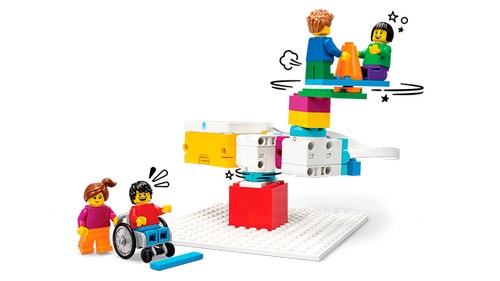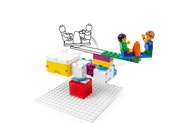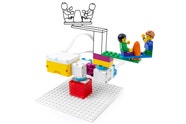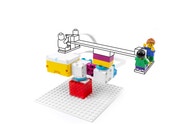Twirling Teacups
Round and round! Sofie and Leo are excited to try this new spinning ride today.

Prepare
- Review the Twirling Teacups lesson in the LEGO® Education SPIKE™ App.
- Consider the abilities and backgrounds of all your students. Differentiate the lesson to make it accessible to everyone. See the Differentiation section below for suggestions.
- If time allows, plan and facilitate the language arts extension. See the Extension section below for more information.
Engage
(Whole Class, 5 Minutes)
- Facilitate a quick discussion about how to consider a specific goal or outcome when refining and improving an existing object.
- Talk with your students about how a spinning amusement park ride works.
- Ask questions, like: If you were adding new seats to a spinning ride, what would those new seats have to be able to do? What would you have to think about as you added the new seats?
- Introduce your students to the story’s main characters and the first challenge: starting the teacup ride.
- Distribute a brick set and a device to each group.
Explore
(Small Groups, 30 Minutes)
- Have your students use the LEGO® Education SPIKE™ App to guide them through their first challenge:
- Create and test the program that starts the teacup ride.
- Have your students iterate and test their models to complete the next two challenges in the app:
- Change the program to improve the teacup ride.
- Upgrade the teacup ride to fit more friends. Make sure that all of the seats can move or spin!
- You can find coding and building support in the Tips section below.
Explain
(Whole Class, 5 Minutes)
- Gather your students together to reflect on their completed challenges.
- Ask questions, like: How did you upgrade the teacup ride? How did you make sure that the new seats moved when the ride was spinning?
Elaborate
(Whole Class, 5 Minutes)
- Prompt your students to discuss and reflect on why it's important to keep the desired outcome or goal in mind when modifying a prototype.
- Ask questions, like: Why is it important to know why you're modifying your prototype, and what your goal is? How do you keep that goal in mind when you're improving or upgrading a prototype?
- Have your students clean up their workstations.
Evaluate
(Ongoing Throughout the Lesson)
- Ask guiding questions to encourage your students to “think aloud” and explain their thought processes and reasoning in the decisions they've made while building and programming.
Observation Checklist
- Measure your students’ proficiency in refining and improving potential prototypes with a specific goal or outcome in mind.
- Create a scale that matches your needs. For example:
- Needs additional support
- Can work independently
- Can teach others
Self-Assessment
- Have each student choose the brick that they feel best represents their performance.
- Yellow: I think I can refine and improve prototypes with a specific goal or outcome in mind.
- Blue: I can refine and improve prototypes with a specific goal or outcome in mind.
- Green: I can refine and improve prototypes with a specific goal or outcome in mind, and I can help a friend do it too.
Peer-Feedback
- In their small groups, have your students discuss their experiences working together.
- Encourage them to use statements like these:
- I liked it when you…
- I'd like to hear more about how you…
Tips
Coding Tip
Your students will use a Message Block when completing their first challenge.
The Message Blocks allow your students to run multiple blocks in parallel.
Whenever a Send Message Block (closed envelope icon) is used, the Received Message Block (same-colored open envelope icon) is activated.
After your students complete their first challenge, they'll be provided with three Inspiration Coding Blocks to help them modify their programs.
The Inspiration Coding Blocks are intended to spark their imaginations as they experiment to find their own solutions.




Model Tip
- After your students complete their second challenge, they’ll be provided with three Inspiration Images and an open-ended prompt for improving their models.
- The Inspiration Images are to help spark their imaginations as they experiment and change their models.




There aren't any building instructions for this challenge.
Differentiation
Simplify this lesson by:
- Shortening the lesson to only include the first challenge
- Selecting one Inspiration Image to help your students change their models
Increase the difficulty by:
- Exploring new and different Coding Blocks in the program
- Investigating how to make the seats spin in different directions
Extension
- Have your students research different rides in an amusement park, select their favorite, and write a persuasive paragraph about why it's the best ride.
If facilitated, this will extend beyond the 45-minute lesson.
Language Arts: CCSS.ELA-LITERACY.W.2.7
Teacher Support
Students will:
- Modify a solution while considering a specific goal or outcome
- Refine and improve the prototype
- Practice helping a story character
- Describe key ideas or details from a text
(one for every two students)
- LEGO® Education SPIKE™ Essential Set
- Device with the LEGO® Education SPIKE™ App installed
- CSTA 1A-AP-08
- NGSS K-2 ETS 1-1
- ISTE 1.4d
- CCSS.ELA-LITERACY.SL.2.2
Language Arts Extension
- CCSS.ELA-LITERACY.W.2.7